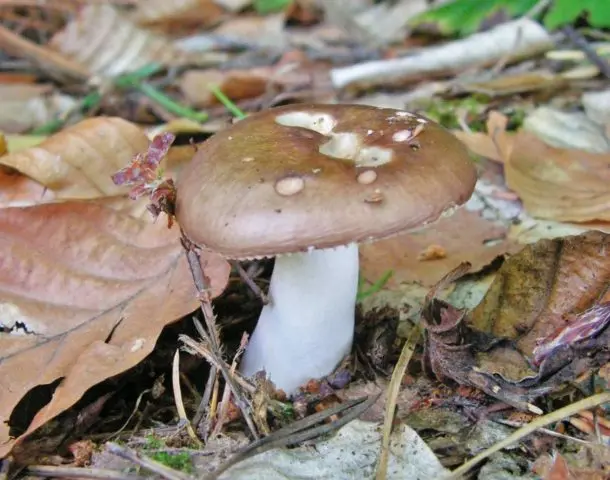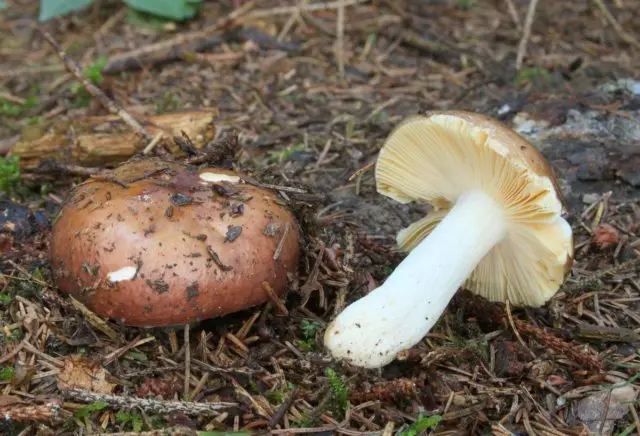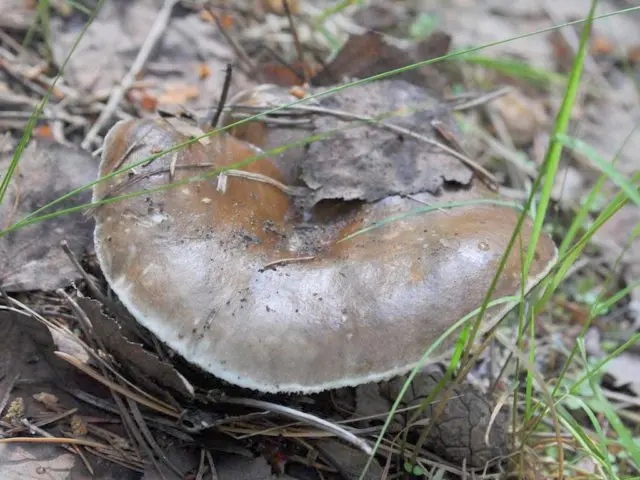Contents
Whole russula is one of the edible mushrooms. Among the synonymous names: wonderful, red-brown, flawless russula. The mushroom belongs to the genus of the same name.

Where Whole Russula Grows
Whole russula prefers calcareous soils. Grows in deciduous and coniferous forests. Often found in mountainous regions. Settles, as a rule, in groups. The most common whole russula in European countries with a temperate climate.

What does whole russula look like?
The hat of a whole russula, like its counterparts, initially has a spherical shape. However, it gradually deforms, becomes prostrate, with a depressed center. The surface of the upper part of the fungus is wavy. The color is bright red, in the middle there is a brown, brown, olive-yellow hue. Hat diameter 5-12 cm.
Fresh skin is dense, slightly slimy, shiny. Takes off the hat well. The edges are gradually covered with grooves, bent upwards. The edging of the cap is weakly meshed, cracked or smooth.
The plates are wide, fleshy, rarely planted. They are not attached to the leg, forked. Spore powder of ocher color.
The leg looks like a cylinder. It grows up to 10 cm in height, 2-3 cm thick. The structure is solid, but over time it becomes spongy inside. The color of the legs is white, yellow spots are visible at the very bottom. The length is often covered with a pink bloom.
The flesh is tender, but very fragile. Young mushrooms have a sweetish taste, overripe specimens have a sharp aftertaste. The color is white, it does not have a pronounced smell.
Is it possible to eat whole russula
Whole russula belongs to the mushrooms of the third category. This is an edible species. Freshly picked fruiting bodies are cleaned of forest debris, washed well enough. Then boiled and attached to the necessary thermal procedures.
The taste of the mushroom
Whole russula does not have a particularly pronounced taste. Therefore, they are collected and cooked only if you really want mushrooms. However, young specimens can be boiled, fried, salted. Spices can give a pleasant taste and aroma.
Benefits and harm to the body
Whole russula contains many useful and nutritious substances. Vitamins E, PP, F, B1, B2, minerals, fatty amino acids, dietary fiber – and these are not all the elements. Mushrooms contain proteins, carbohydrates, fats. Nutritional value – 19 kcal.
A complete product is added to the diet of people on diets. The product helps to reduce weight, fight obesity. This is possible due to a prolonged feeling of fullness and lack of appetite. Suitable for cleaning the digestive tract.
In the juice of mushrooms, scientists discovered the enzyme russulin, which is used to coagulate milk and produce fermented milk products.
From the crushed pulp of whole russula, foot skin care products are made. Active substances soften rough integument, moisturize the feet, and help to remove dry calluses.
Lecithin prevents the appearance of cholesterol in the blood. The daily norm of mushrooms for an adult is 150 g.
Despite all the positive qualities, there is a category of people who should eat mushrooms with caution.
- Patients with chronic diseases of the liver, kidneys, cardiovascular system.
- People with allergic ailments, intolerance to the substances that make up the whole russula.
- If there are violations in the work of the pancreas, gallbladder.
- Women during pregnancy or lactation.
False doubles
Whole russula is outwardly similar to representatives of its kind, but with less pleasant taste.
- Russula is burning-caustic. Inedible variety, even poisonous. The hat grows 5-10 cm in diameter. The color changes: in dry weather, the mushroom is blood-red, after rain the color is pale yellow. Skin is sticky. The leg is smooth, even with white or pink flesh. The taste is acrid, bitter. The aroma is pleasant fruity.

- Russula black. Conditionally edible mushroom. The cap diameter is up to 15 cm. The shape changes from convex to convex. The surface is slightly sticky. The color is dark brown. The size of the leg is 6 cm in height. Its structure is dense, fleshy, but fragile. When broken, the flesh darkens. This species is often found in a pine forest, under trees. According to taste characteristics, it belongs to the 4th group. Used exclusively for salting.

Collection rules
Whole russula begin to bear fruit in July. The process lasts until the onset of cold weather. At the end of September, mushrooms already cease to appear. It is advisable to collect them in the early morning. You need to choose only young, fresh specimens with a slightly sticky skin. They are the tastiest and crunchiest.
The leg is cut off with a knife, so the mycelium remains intact in the ground. The harvested crop is cleaned of forest debris, land. Whole fruits are placed in a bucket or basket. Their structure is rather fragile; if not transported correctly, the mushrooms quickly break.
It is recommended to store whole russula for no more than two days. It is advisable to immediately put them in for processing. Rotten, spoiled fruiting bodies lying in the heat should not be consumed.
Use
With illiterate cooking, you can spoil the taste of a mushroom dish. Whole russula is not suitable for drying. Do not use them for soups. The best option for use is marinating or frying.
It is worth noting that it is not recommended to mix russula with other varieties, because their pulp is quite tender. With prolonged cooking, they fall apart, lose their elastic structure.
Salting is carried out in several ways:
- with a dry procedure, the fruiting bodies are not washed, but wiped with salt, the shelf life is 1 week;
- for cold – it is necessary to soak whole russula in salt water, suitable for consumption after 2 weeks;
- with hot pickling – the mushrooms are boiled for half an hour, after which they are washed with cold water, the product will be ready after 1 month.
The next steps are the same. Pre-prepared mushrooms are placed in a container. Sprinkle each layer with salt. The norm for 500 g is 1-1,5 tbsp. l. salt. It is important not to forget to add spices: bay leaf, black peppercorns, cloves, allspice. During the specified time, observe that there is no mold. Be sure to keep the container in a cold place.
There is an opinion that whole russula can be consumed raw. However, it is not. The pulp contains a large amount of bitterness, which is removed by heat treatment. A fresh mushroom, of course, will not kill a person, but it can cause discomfort and upset the gastrointestinal tract.
Conclusion
Whole russula is an edible mushroom. Use a variety for pickling, pickles, frying. After cooking, the taste is sweetish, pleasant. However, you should know all the external signs, so as not to be confused with false twins.












